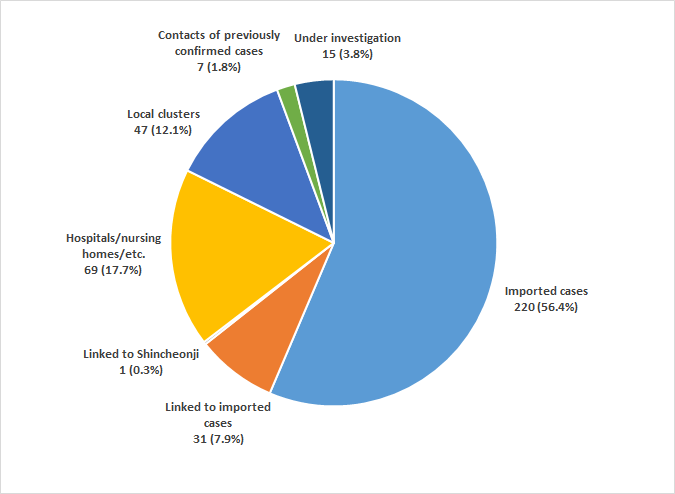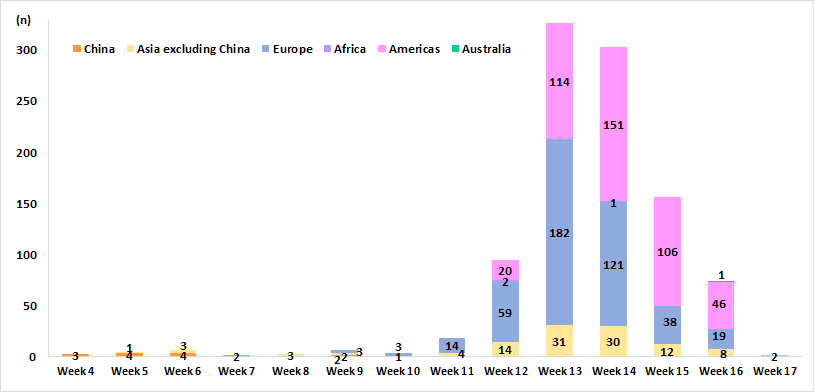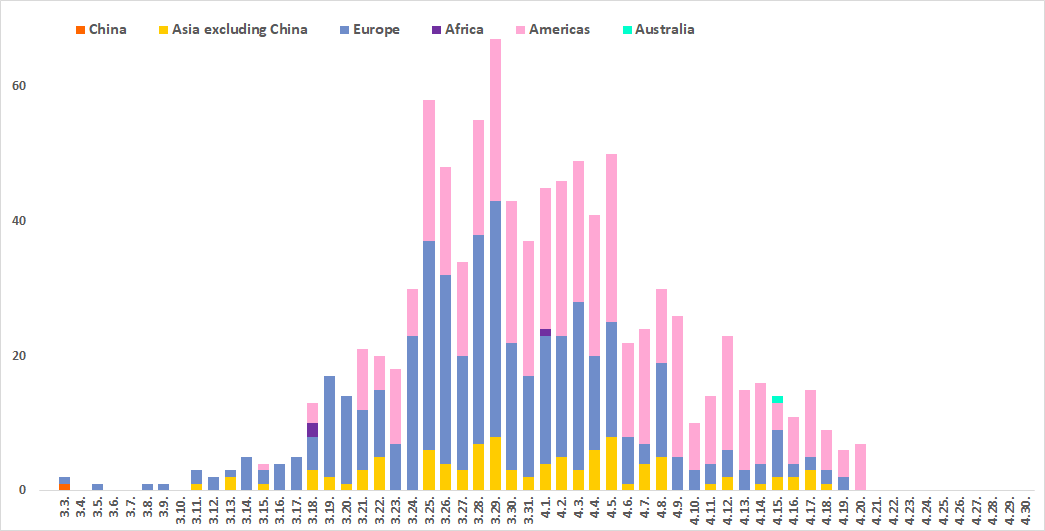contents area
Press Release
detail content area
- Date2020-04-20 20:25
- Update2020-04-20 20:26
- DivisionDivision of Risk assessment and International cooperation
- Tel043-719-7556
Updates on COVID-19 in Republic of Korea
20 April, 2020
○ As of 0:00, 20 April 2020, a total of 10,674 cases (including 1,006 imported cases) have been confirmed, of which 8,114 cases (76.0%) have been discharged from isolation. Newly confirmed cases are 13 in total.
[Table 1. Total confirmed and suspected cases]
|
Period (since 3 Jan) |
Total |
Tested positive |
Being tested |
Tested negative |
|||
|
Confirmed |
Discharged from isolation |
Under isolation |
Deceased |
||||
|
As of 0:00 19 April (Sun) |
559,109 |
10,661 |
8,042 |
2,385 |
234 |
12,243 |
536,205 |
|
As of 0:00 20 April (Mon) |
563,035 |
10,674 |
8,114 |
2,324 |
236 |
11,981 |
540,380 |
|
Difference |
(+)3,926 |
(+)13 |
(+)72 |
(-)61 |
(+)2 |
(-)262 |
(+)4,175 |
[Table 2. Imported cases in Korea (as of 0:00, 20 April 2020)]
|
|
Total |
Region/Country |
Where confirmed |
Nationality |
|||||||
|
China |
Asia ex-China |
Europe |
Americas |
Africa |
Australia |
Point of Entry |
Community |
Korean |
Other |
||
|
New |
7 |
0 |
0 |
0 |
7 |
0 |
0 |
4 |
3 |
6 |
1 |
|
Total |
1,006 |
16 |
108 |
439 |
439 |
3 |
1 |
418 |
588 |
922 |
84 |
|
(1.6%) |
(10.7%) |
(43.6%) |
(43.6%) |
(0.3%) |
(0.1%) |
(41.6%) |
(58.4%) |
(91.7%) |
(8.3%) |
||
* Figures may change based on findings from ongoing local epidemiological investigation efforts.
○ Epidemiological links have been found for 81.0% of the total cases; 9.6% are either under investigation or sporadic cases. More details on the epidemiological links within each province or city are shown in Table 3.
○ From Busan City, 1 worker at Busan Medical Center and 1 family member were confirmed. Infection prevention measures and epidemiological investigation are underway.
○ From Yecheon-gun, Gyeongbuk Province, 2 additional cases were confirmed during contact investigation. In total, 37 cases (including 3 in Andong City and 1 in Mungyeong City) have been confirmed since 9 April.
(The figures in Table 3 are based on cases reported to KCDC before 0:00 of 20 April and may differ from above.)
○ KCDC released interim analysis of the 1,006 imported cases as of 0:00 of 20 April.
- Imported cases contributed 9.4% of total 10,674 confirmed cases.
- First imported case was a patient from China on 20 January. Imported cases surged in March. China and other Asian countries made up a large proportion in the beginning, then Europe in March, and Americas in April.
- Importation was highest during 22 March – 4 April; 61.7% (621 cases) of all imported cases occurred during this 14-day period.
- In terms of location, 418 (41.6%) cases were confirmed at entry screening; 244 (24.3%) in Seoul; 151 (15.0%) in Gyeonggi Province; 41 (4.1%) in Incheon City.
- In terms of nationality, 922 (91.7%) were Korean nationals; 84 (8.3%) were foreign nationals.
- Of all imported cases, 61 have caused local transmission. In total, 157 cases were infected from imported cases. Among the local transmissions caused by imported cases, 89 (54.4%) were family members; 33 (20.6%) were friends or acquaintances; 27 (16.9%) were people at work; 8 (6.3%) were infected from places visited by imported cases.
- With stronger entry screening and monitoring policy for inbound travelers that took effect since 1 April, no imported case arriving on or after 1 April has caused local transmission as of date.
- Persons under home quarantine (self-quarantine) are required to comply with home quarantine guidelines including not sharing personal items with or coming in contact with family, roommates, or cohabitants.
- Family members, roommates, or cohabitants should also ensure that their personal items are kept separate from the person under quarantine. They should clean all frequently touched surfaces often and refrain from coming in contact with the person under quarantine as much as possible.
○ Following the end (19 April) of the previous Enhanced Social Distancing campaign, KCDC is leading a slightly relaxed form of social distancing campaign until 5 May.
- High-risk facilities including nightlife entertainment venues, some fitness/sports venues, private academies, and religious facilities are recommended to refrain from operation (previously “recommended to suspend operation”). Facilities that remain in operation are required to comply with infection prevention and control guidelines (same as before).
- People are recommended to refrain from non-essential social gatherings or events. Essential exams and other unavoidable events will be allowed on a limited basis on the condition that infection prevention/control guidelines are followed.
- National parks, recreation forests, arboreta and other relatively lower-risk “outdoor, dispersed” facilities that have suspended operation may gradually reopen in phases on the condition that they implement infection prevention/control policy measures. “Outdoor, concentrated” facilities that can meet the “dispersion” requirement (e.g., professional baseball games held without any fans) will be allowed to reopen on a limited basis.
○ KCDC stressed that the new Social Distancing policy/campaign (effective until 5 May) should not be interpreted as return to normal life as before.
- KCDC recommended that any facility that makes it easy for people to come in close contact with other people in an enclosed space should refrain from operating as much as possible. Such facilities that have to remain in operation should comply with infection prevention/control guidelines including checking all users for fever or respiratory symptoms, keeping a log of all users, requiring everyone to wear facemasks and keep distance from each other, and disinfecting and ventilating the space.
- KCDC stressed that reducing contact with other people as much as possible and maintaining personal hygiene are highly important to preventing COVID-19.
- People who cannot avoid visiting an enclosed/crowded place should keep at least 2 meters of distance from others, wear a facemask, and maintain hand hygiene by washing hands or using hand sanitizers.
- KCDC also stressed that people who have suspected COVID-19 symptoms should not go to work or leave home and should go to a screening center to be tested.
[Table 3: Regional distribution and epidemiological links of the confirmed cases]
|
Region |
Confirmed cases |
Other major clusters |
||||||||
|
Total |
Imported cases |
Clusters |
Other* |
New cases |
||||||
|
Sub- total |
Shin- cheonji |
Other clusters |
Contacts of confirmed cases |
Imported cases |
||||||
|
Seoul |
624 |
244 |
357 |
8 |
262 |
18 |
69 |
23 |
0 |
Guro-gu call center (98), Dong-an Church-PC Cafe (20), Manmin Central Church (41), etc. |
|
Busan |
132 |
20 |
81 |
12 |
50 |
18 |
1 |
31 |
2 |
Onchun Church (39), Suyeong-gu Kindergarten (5), etc. |
|
Daegu |
6833 |
17 |
6095 |
4510 |
659 |
922 |
4 |
721 |
1 |
Second Mi-Ju Hospital (195), Hansarang Convalescent Hospital (127), Daesil Convalescent Hospital (100), Fatima Hospital (36), etc. |
|
Incheon |
92 |
41 |
47 |
2 |
34 |
5 |
6 |
4 |
1 |
Guro-gu call center (20), etc. |
|
Gwangju |
30 |
14 |
16 |
9 |
0 |
1 |
6 |
0 |
0 |
|
|
Daejeon |
39 |
9 |
21 |
2 |
11 |
8 |
0 |
9 |
0 |
Korea Forest Engineer Institute (3), etc. |
|
Ulsan |
43 |
12 |
24 |
16 |
1 |
4 |
3 |
7 |
1 |
|
|
Sejong |
46 |
3 |
42 |
1 |
38 |
3 |
0 |
1 |
0 |
Ministry of Oceans and Fisheries (30), gym facilities (8) |
|
Gyeonggi |
656 |
151 |
464 |
29 |
318 |
55 |
62 |
41 |
2 |
Grace River Church in Seongnam (72), Guro-gu call center-Bucheon SaengMyeongSu Church (48), Uijeongbu St. Mary’s Hospital (49), etc. |
|
Gangwon |
53 |
14 |
32 |
17 |
15 |
0 |
0 |
7 |
0 |
Apartments in Wonju City (3), Euijeongbu St. Mary’s Hospital (10), etc. |
|
Chung- |
45 |
5 |
32 |
6 |
18 |
6 |
2 |
8 |
0 |
Goesan-gun Jangyeon-myeon (11) |
|
Chung- |
141 |
11 |
120 |
0 |
118 |
1 |
1 |
10 |
0 |
Gym facilities in Cheonan (103), research center in Seosan (9), etc. |
|
Jeonbuk |
17 |
8 |
4 |
1 |
3 |
0 |
0 |
5 |
0 |
|
|
Jeonnam |
15 |
7 |
7 |
1 |
3 |
2 |
1 |
1 |
0 |
Manmin Central Church (2) |
|
Gyeong- |
1361 |
10 |
1217 |
566 |
460 |
191 |
0 |
134 |
2 |
Cheongdo Daenam Hospital (120), Bonghwa Pureun Nursing Home (68), pilgrimage to Israel (49), Gyeongsan Seo Convalescent Hospital (66), Yecheon-gun (37), etc. |
|
Gyeong- |
116 |
14 |
84 |
32 |
45 |
6 |
1 |
18 |
0 |
Geochang Church (10), Geochang Woongyang-myeon (8), Wings Tower (10), etc. |
|
Jeju |
13 |
8 |
1 |
0 |
0 |
0 |
1 |
4 |
0 |
|
|
Airport |
418 |
418 |
0 |
0 |
0 |
0 |
0 |
0 |
4 |
|
|
Total |
10674 |
1006 |
8644 |
5212 |
2035 |
1240 |
157 |
1024 |
13 |
|
|
(9.4) |
(81.0) |
(48.8) |
(19.1) |
(11.6) |
(1.5) |
(9.6) |
||||
|
* Not classified into a cluster or under investigation ※ The interim classification is based on the reporting location, which may change depending on further epidemiological investigation. |
||||||||||
[Figure 1: Distribution of confirmed cases based on location reported]
* Refer to attachment
[Table 4: Age distribution of severe cases]
|
Age group |
Total |
Severe |
( |
% |
) |
Very severe |
( |
% |
) |
|
Total |
56 |
22 |
( |
100.0 |
) |
34 |
( |
100.0 |
) |
|
80 or above |
9 |
4 |
( |
18.2 |
) |
5 |
( |
14.7 |
) |
|
70-79 |
29 |
12 |
( |
54.5 |
) |
17 |
( |
50.0 |
) |
|
60-69 |
12 |
4 |
( |
18.2 |
) |
8 |
( |
23.5 |
) |
|
50-59 |
2 |
0 |
( |
0.0 |
) |
2 |
( |
5.9 |
) |
|
40-49 |
2 |
0 |
( |
0.0 |
) |
2 |
( |
5.9 |
) |
|
30-39 |
0 |
0 |
( |
0.0 |
) |
0 |
( |
0.0 |
) |
|
20-29 |
2 |
2 |
( |
9.1 |
) |
0 |
( |
0.0 |
) |
|
10-19 |
0 |
0 |
( |
0.0 |
) |
0 |
( |
0.0 |
) |
|
0-9 |
0 |
0 |
( |
0.0 |
) |
0 |
( |
0.0 |
) |
[Table 5: Distribution of cases that retested positive]
|
Age group |
Total |
|
% |
) |
|
Total |
181 |
( |
100.0 |
) |
|
80 or above |
16 |
( |
8.9 |
) |
|
70-79 |
7 |
( |
3.9 |
) |
|
60-69 |
20 |
( |
11.0 |
) |
|
50-59 |
32 |
( |
17.7 |
) |
|
40-49 |
26 |
( |
14.4 |
) |
|
30-39 |
27 |
( |
14.9 |
) |
|
20-29 |
42 |
( |
23.2 |
) |
|
10-19 |
6 |
( |
3.3 |
) |
|
0-9 |
5 |
( |
2.8 |
) |
[Figure 2: New cases (for last 2 weeks) by chain of transmission]

[Figure 3-4: Weekly/daily trend of imported cases]


 This public work may be used under the terms of the public interest source + commercial use prohibition + nonrepudiation conditions
This public work may be used under the terms of the public interest source + commercial use prohibition + nonrepudiation conditions